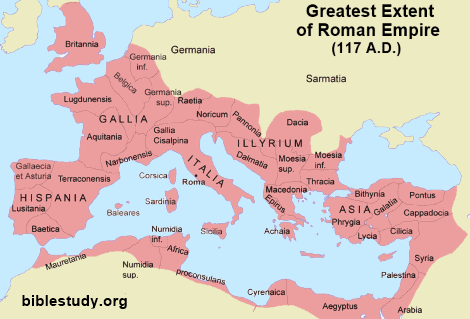The Roman Republic began after the overthrow of the monarchy around 509 B.C. Two consuls, advised by the Senate, governed the Republic from its creation to about 27 B.C. The election of consuls took place annually. During this period a Roman constitution gradually developed, based upon a separation of powers and a system of checks and balances within the government.
Public offices during this era were generally limited to one year so that no single person could control and dominate the people. The Roman Republic system lasted roughly 450 years before it eventually transitioned to a single-ruler, Emperor-based government at the beginning of the empire period in the late first century B.C.
The death of the Roman Republic and start of the empire is a subject of debate among some historians and scholars. Some believe the change took place in 44 B.C. when Julius Caesar became perpetual dictator. Others believe the transition occurred at the defeat of Mark Antony at the Battle of Actium in 31 B.C.

It seems likely, however, that the republic ended and the empire began when the Roman Senate granted extraordinary powers to Octavian (Augustus) in 27 B.C. The first true Roman Emperor, therefore, is Augustus Caesar, who ruled from 27 B.C. to 14 A.D. After his reign came that of Tiberius (14 to 37 A.D.), Caligula (37 to 41 A.D.), Claudius (41 A.D. to 54 A.D.), and Nero (54 to 68 A.D.).
After the death of Nero, until the end of the first century, the Roman empire was reigned by Galba (68 to 69), Otho (69), Vitellius (69), and Vespasian (69 to 79). General Titus became emperor after Vespasian.
Titus was the man who led a campaign against Judea and destroyed Jerusalem and its temple in 70 A.D. Domitian followed him as Emperor in 81 A.D. Emperor Domitian exiled the apostle John to the Island of Patmos in 95 A.D. Following him as ruler is Nerva (96 to 98) and Trajan (98 to 117).
Year of Four Emperors
After the death of Nero, around May of 68, Rome entered a short period of chaos and civil war known as the 'Year of Four Emperors.' In this period, four Roman emperors would rule in quick succession. Galba reigned from June 68 A.D. to his murder by Praetorian guards in January 69 A.D.
Otho then came to power and lasted only until he committed suicide in April 69 after losing a battle. Vitellius then took the reins of power but he too, like Galba, was murdered. After Vitellius' death, the Senate declared Vespasian Roman Emperor on December 20 of 69.
The Peak of Power
After Domitian's death, the empire reached its peak of power and wealth under the rule of the 'Five Good Emperors.' These rulers, known for their moderate policies, were in contrast to their more tyrannical and oppressive predecessors and successors. The below reigning dates of the good emperors are all in A.D.
The Good Roman Emperors
Nerva | 96 - 98 |
Trajan | 98 - 117 |
Hadrian | 117 - 138 |
Antoninus Pius | 138 - 161 |
Marcus Aurelius | 161 - 180 |
The good emperors period was particularly notable for its peaceful method of succession, where each emperor chose his successor by adopting an heir. This prevented the political turmoil associated with unstable and weak governments. Secure from both internal and external threats these Roman rulers governed during a time of unprecedented territorial, economic, and cultural expansion.
The greatest extent of Roman territorial expansion occurred with Trajan's conquest of Dacia in 117 A.D. Rome is considered the third largest and most powerful ancient empire, behind the first place Persian and second place Han dynasty. At the time of Jesus, it had a total population of about 60 million people.
Fighting God
The Roman empire and its impact on Christianity was enormous. Rome carried out ten waves of persecution against Christians, the first of these began by Emperor Nero in 67 A.D. He instigated the torture and death of believers, many times as sport in the Circus Maximus, in order to deflect criticism of himself. During this first purge, the apostles Paul and Peter died a martyr's death.
The tenth and last of these Roman state sponsored persecutions began under Diocletian (284 to 305 A.D.). All during this period, in spite of the concentrated efforts to stamp out God's truth through the martyrdom of countless saints, believers in the Bible continued to multiple. The persecutions by the state finally ended in 313 A.D. when Constantine, in his Edict of Milan, legalized Christianity and ended the violence.